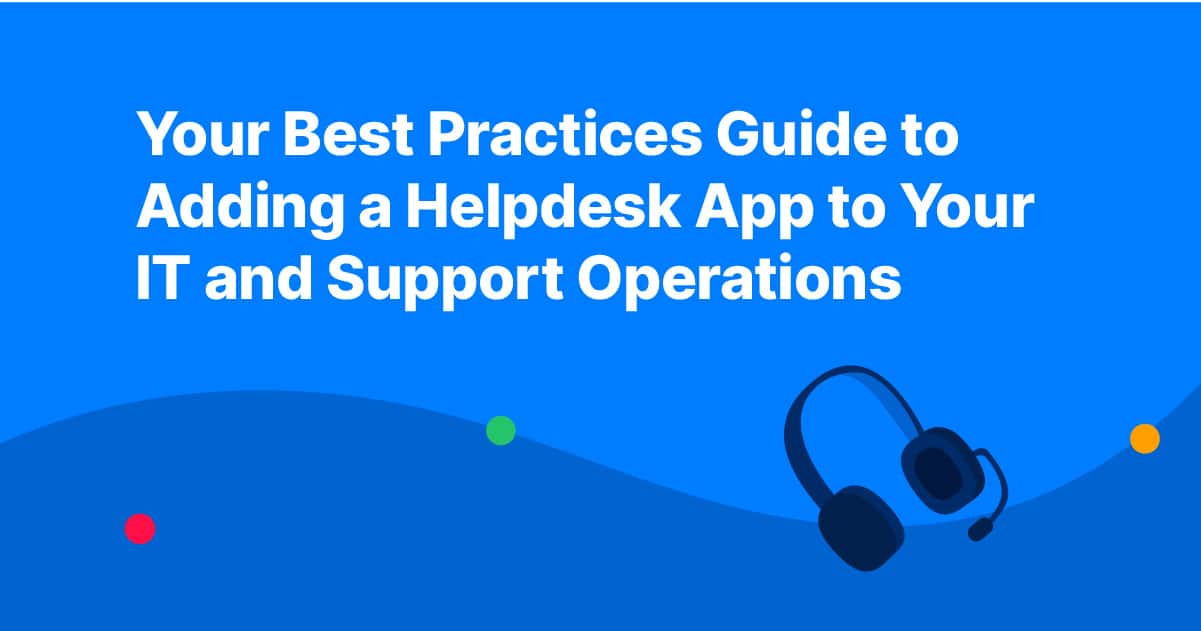Adding a helpdesk app to your IT and support operations is like hiring a personal assistant. Just as a PA takes care of all the nitty-gritty details, a helpdesk app can streamline and automate your support operations. This then frees up time and energy for your team to focus on the bigger picture.
But, of course, not all helpdesk apps are created equal. So, in this guide, we’ll look at some of the biggest considerations for your helpdesk. Then we’ll jump into some best practices.
But first –
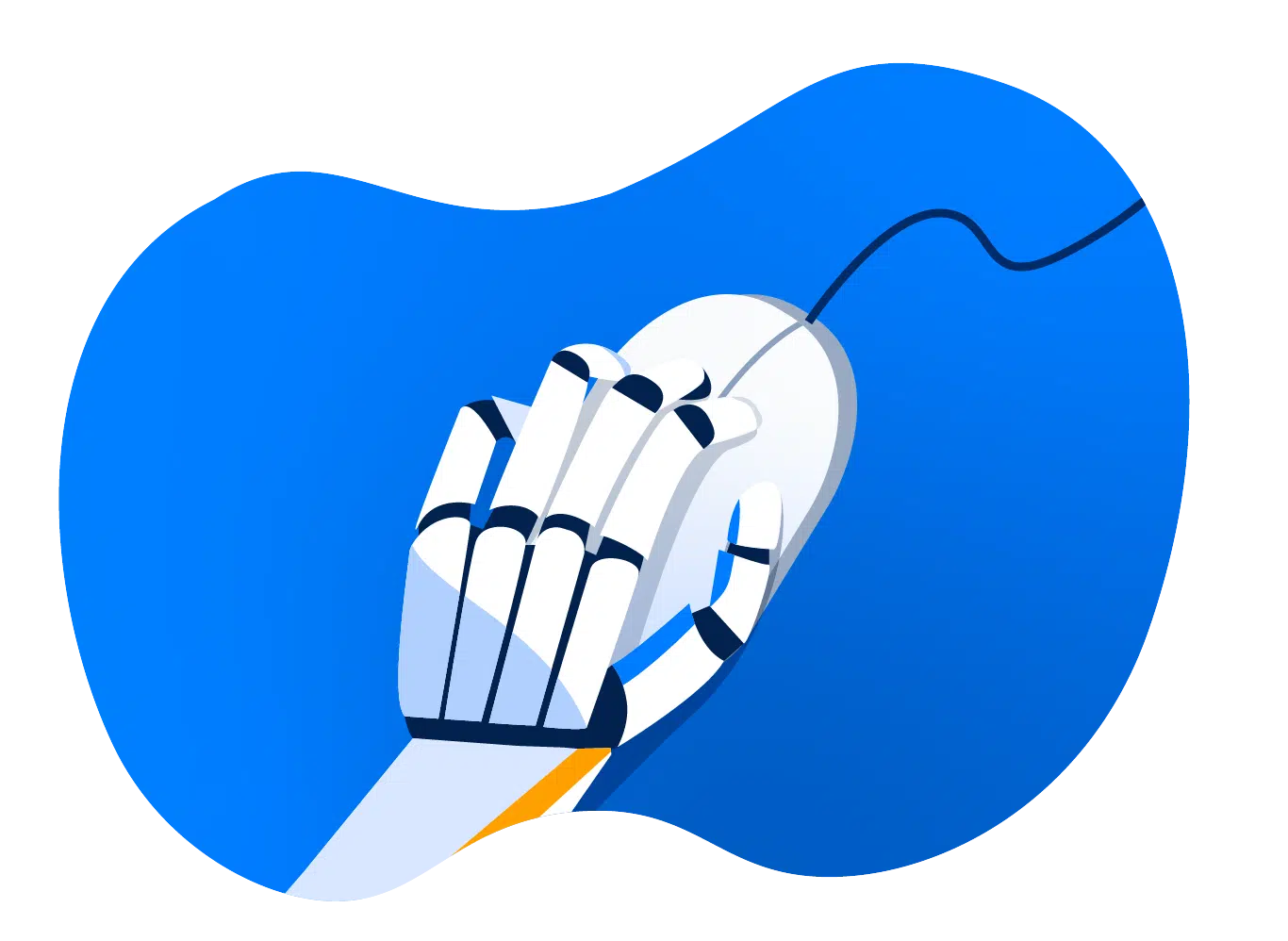
Automate Your Work
Capacity’s enterprise AI chatbot can help:
- Answer FAQs anytime, anywhere
- Find relevant documents within seconds
- Give surveys and collect feedback
What is a helpdesk app?
Simply put, a helpdesk app is a computer program that helps businesses answer questions and fix problems for their customers. It keeps everything organized so you can provide the best customer service.
You might use a helpdesk app to simplify the process of helping people. When your customers have a question or problem, they can use the app to connect with your support team. What’s more, your internal teams can use it, too, for IT support. The app keeps track of all the requests, so your team can respond and help to fix the problems fast.
An app can also help you keep track of common problems and find ways to fix them. That way, you can provide better service in the future.
What are Some Advantages of Using a Helpdesk App?
There are tons of benefits to using a helpdesk app for your business. Here are some:
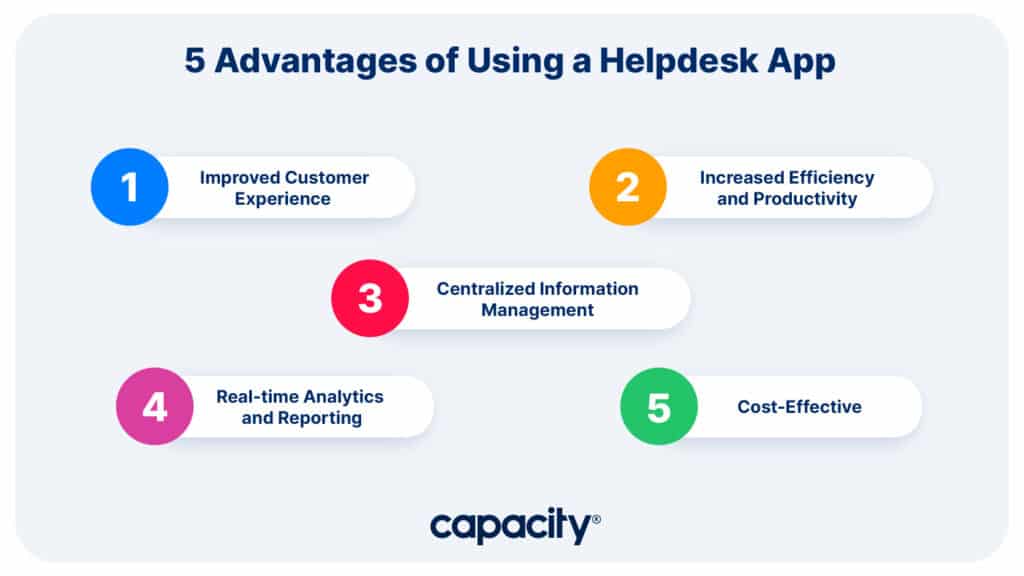
Improved customer experience
You can respond super fast to customer inquiries and complaints using a helpdesk app. And you can add in automation like ticket routing, prioritization, and AI-driven responses. Those features will help you scale personalization in your support.
Increased efficiency and productivity
With a helpdesk app, you can automate and streamline your customer support operations. That leads to a big boost in efficiency and productivity. For instance, you can automate repetitive tasks, like ticket creation and response. That then frees up your team to focus on more complex customer issues.
Centralized information management
A helpdesk app provides a centralized platform for managing customer support requests. This lets you track and organize inquiries, complaints, and tickets. It also makes it easier for your team to collaborate and share info to resolve issues faster.
Real-time analytics and reporting
Get real-time analytics and reporting inside your helpdesk app. That can help you track your team’s productivity and performance while also ID trends. You can then use the info to make data-driven decisions on where to improve your experience.
Cost-effective
A helpdesk app can streamline your support operations and improve your efficiency. By centralizing all your requests into one place, your team can manage and respond fast. And that’ll reduce the workload on your support staff, letting them handle more in less time. That also means you might need fewer support staff members. So, when natural attrition happens, you might not need to replace some folks.
A helpdesk app can also ID common problems and finds ways to address them, which reduces the number of tickets in the future. And that means you may be able to devote fewer resources to support, resulting in even more savings.
Helpdesk app vs. desktop support
A helpdesk app and desktop support are two similar (yet different) methods of providing customer or technical support. While both aim to support the end-user, there are a few distinct differences.
Helpdesk app
A helpdesk app is a software tool that lets teams manage and track customer support requests. Customers can submit their requests through several channels, and it’s tracked in one spot.
Often, a helpdesk app has some (or a lot…) of automation. For instance, it may have automatic ticket routing or AI features. This lets your team handle issues fast.
Desktop support
Desktop support involves providing on-site support to end users. Most often, it involves technical issues like hardware repairs or software installs. It’s mostly focused on things that you can’t do remotely.
Desktop support technicians work directly with end-users to troubleshoot and resolve technical issues.
Features of helpdesk apps
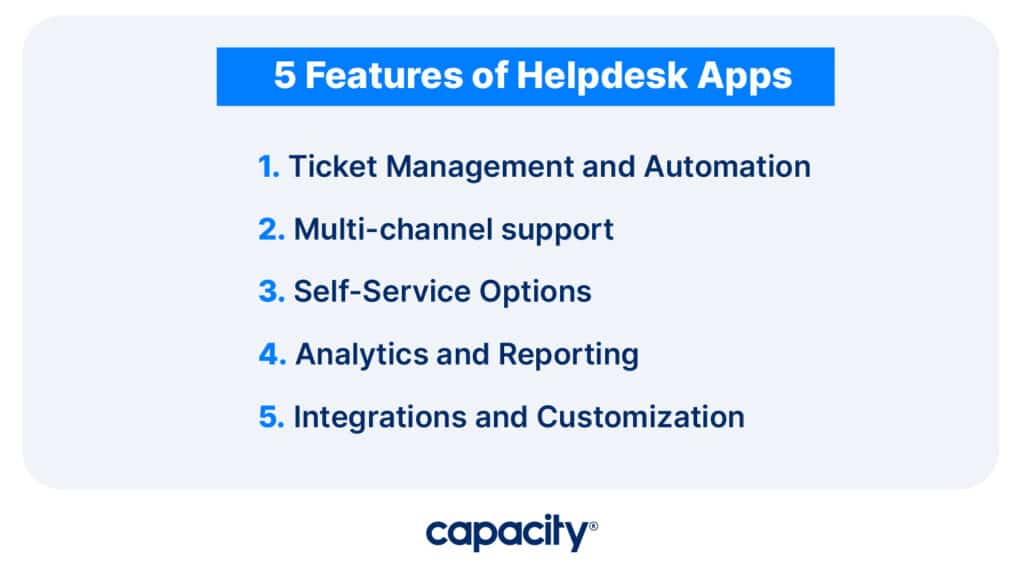
Some common features of Helpdesk Apps include:
Ticket management and automation:
A helpdesk app is one place for all support requests to live, which makes managing tickets easy. Add in automation, and you can take things like ticket creation and routing off your team’s plates.
Multi-channel support
Provide support through several channels like email, chat, SMS, voice, and so on. This lets you offer support where your customers are, boosting satisfaction.
Multi-channel support in a helpdesk app also lets you track and manage requests from all channels in one place. This gives you a single source of truth. And that makes it easier to provide consistent, high-quality support.
Self-service options
Start providing self-service to your customers and teams with a helpdesk app. It can serve up things like a knowledge base or FAQ section, which helps folks help themselves. (Without contacting support.)
Self-service can save you both time and resources, as customers can solve issues on their own. Self-service options in an IT helpdesk app can also add to the CX by giving your team quick and easy access to info.
Analytics and reporting
Helpdesk applications provide real-time analytics and reporting capabilities. That lets you track your support team’s performance and customer feedback. Plus, it can identify areas for improvement.
Integrations and customization
Integrate with your existing systems, like your CRM or CCaaS platform. This lets you streamline your ops and provide a consistent, wonderful experience.
Avoid common customer support mistakes with a helpdesk app
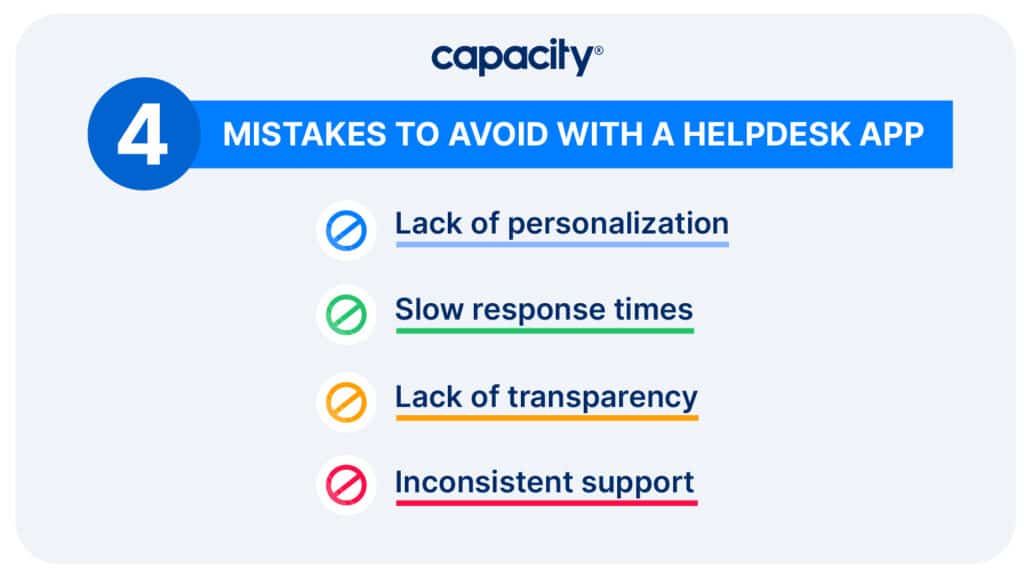
Lack of personalization
Using a helpdesk app can help you avoid the mistake of treating customers like numbers. Store customer information and history inside your platform to tailor your interactions.
Slow response times
Some 73% of customers say valuing their time is the most important thing you can do to give them a great experience. A helpdesk can help you automate notifications and alerts for new tickets. Some platforms can even answer questions autonomously (like ours!).
Lack of transparency
Transparency is essential in customer support. A helpdesk app helps you avoid the mistake of leaving customers in the dark about their status. You can give customers real-time updates on their tickets and inform them of any changes.
Inconsistent support
Consistent support is crucial to building trust with customers. A helpdesk app can help automate responses and templates for FAQs.
This can help ensure all customers get the same level of support, regardless of who they speak with.
Best practices for implementing a helpdesk application in your business
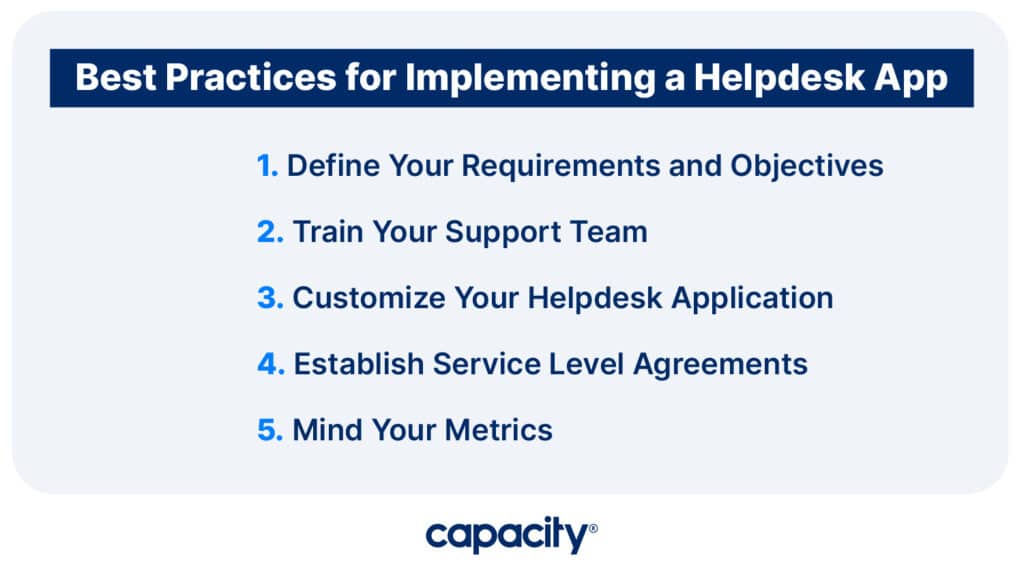
Here are some best practices for implementing a Helpdesk application in your business.
Define your requirements and objectives
Before implementing a Helpdesk application, defining your requirements and objectives is important. This involves identifying the types of support requests your business receives, the channels through which you provide support, and your team’s workflows.
You should also define your objectives for implementing the Helpdesk application, such as improving response times or increasing customer satisfaction.
Train your support team
Once you’ve implemented a Helpdesk application, training your support team on how to use it effectively is important. This includes teaching them how to create and manage tickets, prioritize support requests, and use any available automation features.
An effective Helpdesk automation feature can reduce the workload for your support team, freeing up their time to focus on more complex issues.
Customize your helpdesk application
Helpdesk applications offer a range of customization options, such as branding, ticket fields, and workflows. Taking advantage of these options is important to tailor the application to your business needs.
You should also ensure that the Helpdesk application integrates with your existing software and systems, such as your CRM or marketing automation platform.
Establish service level agreements
SLAs are agreements between your business and your customers that define the level of support they can expect to receive.
When implementing a Helpdesk application, it’s important to establish SLAs that align with your business objectives and capabilities. This includes setting response times, prioritization levels, and escalation procedures.
Mind your metrics
Helpdesk applications provide real-time metrics and reporting capabilities, allowing you to track your team’s performance and identify areas for improvement.
Monitoring these metrics regularly is important to ensure that your Helpdesk application is helping you achieve your objectives.
How can Capacity be the solution to your helpdesk needs?
If you are looking for a comprehensive solution to help desk needs for your business, Capacity may be the answer. Here are a few reasons why:
All-in-one helpdesk
Capacity’s conversational AI and low-code platform enable it to answer more than 90% of frequently asked questions and reduce the tickets in your support team’s queue. This means that your support team can focus on more complex issues, resulting in faster and more effective customer support.
Automated workflows
Capacity’s workflow automation suite and robust developer platform can automate monotonous processes and tasks, increasing productivity in cross-functional teams. This means that teams can focus on higher-level tasks and initiatives, resulting in a more efficient and streamlined business process.
User-friendly knowledge base and app integrations
Capacity provides businesses with a user-friendly knowledge base, a suite of app integrations, and a conversational interface, empowering employees with access to the information they need. This means that employees can quickly and easily find the information they need, resulting in faster and more effective decision-making.
Flexible deployment options
Capacity’s flexible database can be deployed anywhere, allowing businesses to customize their support and business processes to meet their unique needs. This means that businesses can easily integrate Capacity into their existing systems and workflows, resulting in a more seamless and efficient operation.

Automate Your Work
Capacity’s enterprise AI chatbot can help:
- Answer FAQs anytime, anywhere
- Find relevant documents within seconds
- Give surveys and collect feedback











































